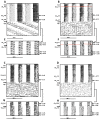Photoperiodic Requirements for Induction and Maintenance of Rhythm Bifurcation and Extraordinary Entrainment in Male Mice
- PMID: 33089170
- PMCID: PMC7445826
- DOI: 10.3390/clockssleep1030025
Photoperiodic Requirements for Induction and Maintenance of Rhythm Bifurcation and Extraordinary Entrainment in Male Mice
Abstract
Exposure of mice to a 24 h light:dark:light:dark (LDLD) cycle with dimly illuminated nights induces the circadian timing system to program two intervals of activity and two intervals of rest per 24 h cycle and subsequently allows entrainment to a variety of extraordinary light regimens including 30 h LDLD cycles. Little is known about critical lighting requirements to induce and maintain this non-standard entrainment pattern, termed "bifurcation," and to enhance the range of apparent entrainment. The current study determined the necessary duration of the photophase for animals to bifurcate and assessed whether requirements for maintenance differed from those for induction. An objective index of bifurcated entrainment varied with length of the photophase over 4-10 h durations, with highest values at 8 h. To assess photic requirements for the maintenance of bifurcation, mice from each group were subsequently exposed to the LDLD cycle with 4 h photophases. While insufficient to induce bifurcation, this photoperiod maintained bifurcation in mice transferred from inductive LDLD cycles. Entrainment to 30 h LDLD cycles also varied with photoperiod duration. These studies characterize non-invasive tools that reveal latent flexibility in the circadian control of rest/activity cycles with important translational potential for addressing needs of human shift-workers.
Keywords: SCN; T cycles; bifurcation; circadian entrainment; oscillator coupling; phase-shifting; shift-work.
© 2019 by the authors.
Conflict of interest statement
Conflicts of InterestThe authors declare no conflict of interest. The funders had no role in the design of the study; in the collection, analyses, or interpretation of data; in the writing of the manuscript, or in the decision to publish the results.
Figures




Similar articles
-
Dim nighttime illumination interacts with parametric effects of bright light to increase the stability of circadian rhythm bifurcation in hamsters.Chronobiol Int. 2011 Jul;28(6):488-96. doi: 10.3109/07420528.2011.591952. Chronobiol Int. 2011. PMID: 21797777
-
Simple Lighting Manipulations Facilitate Behavioral Entrainment of Mice to 18-h Days.J Biol Rhythms. 2017 Aug;32(4):309-322. doi: 10.1177/0748730417718347. Epub 2017 Aug 3. J Biol Rhythms. 2017. PMID: 28770653
-
Entrainment of 2 subjective nights by daily light:dark:light:dark cycles in 3 rodent species.J Biol Rhythms. 2003 Dec;18(6):502-12. doi: 10.1177/0748730403260219. J Biol Rhythms. 2003. PMID: 14667151
-
Extraordinary behavioral entrainment following circadian rhythm bifurcation in mice.Sci Rep. 2016 Dec 8;6:38479. doi: 10.1038/srep38479. Sci Rep. 2016. PMID: 27929128 Free PMC article.
-
Circadian and Metabolic Effects of Light: Implications in Weight Homeostasis and Health.Front Neurol. 2017 Oct 19;8:558. doi: 10.3389/fneur.2017.00558. eCollection 2017. Front Neurol. 2017. PMID: 29097992 Free PMC article. Review.
Cited by
-
Enhanced Circadian Entrainment in Mice and Its Utility under Human Shiftwork Schedules.Clocks Sleep. 2019 Aug 26;1(3):394-413. doi: 10.3390/clockssleep1030032. eCollection 2019 Sep. Clocks Sleep. 2019. PMID: 33089177 Free PMC article.
-
Naturalistic Intensities of Light at Night: A Review of the Potent Effects of Very Dim Light on Circadian Responses and Considerations for Translational Research.Front Neurol. 2021 Feb 1;12:625334. doi: 10.3389/fneur.2021.625334. eCollection 2021. Front Neurol. 2021. PMID: 33597916 Free PMC article. Review.
-
Reorganization of circadian activity and the pacemaker circuit under novel light regimes.Proc Biol Sci. 2024 Aug;291(2027):20241190. doi: 10.1098/rspb.2024.1190. Epub 2024 Jul 24. Proc Biol Sci. 2024. PMID: 39043245 Free PMC article.
-
Reversible suppression of circadian-driven locomotor rhythms in mice using a gradual fragmentation of the day-night cycle.Sci Rep. 2023 Sep 2;13(1):14423. doi: 10.1038/s41598-023-41029-0. Sci Rep. 2023. PMID: 37660212 Free PMC article.
References
-
- Moore R.Y. The Suprachiasmatic Nucleus and the Circadian Timing System. Prog. Mol. Biol. Transl. Sci. 2013;119:1–28. - PubMed

